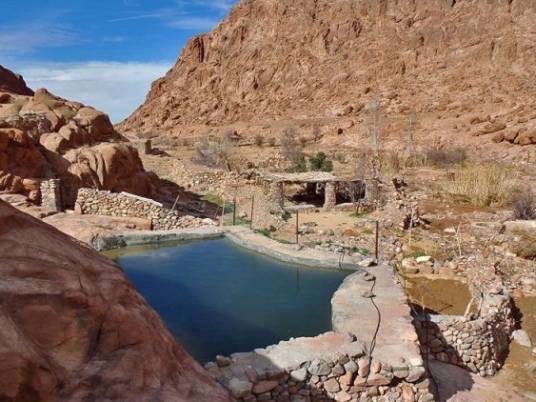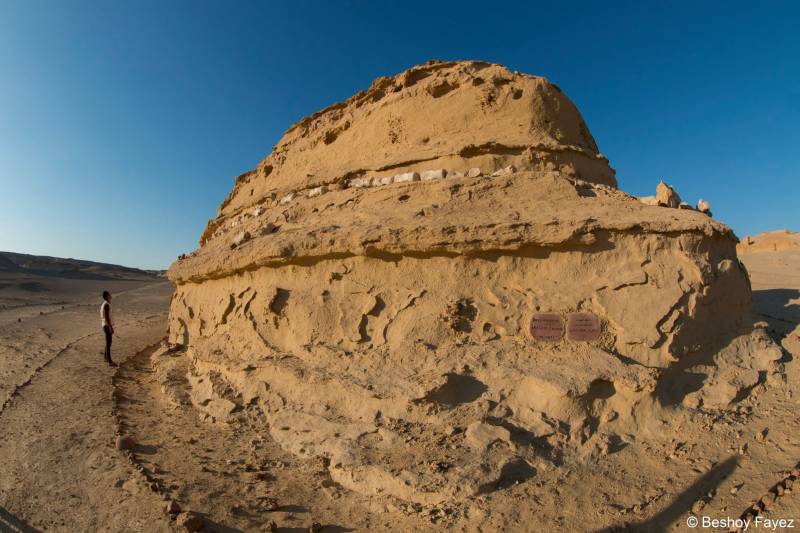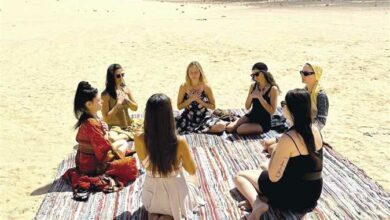
Around St. Catherine’s Monastery, encircled by the high South Sinai mountains, lie hundreds of Bedouin gardens nested in the nearby wadis, or valleys. These gardens, which were initially built during the Byzantine period by monks, hermits and settlers from around the Mediterranean, have been the responsibility of the Jabaleya Bedouins for more than a century.
A severe drought that lasted for years in the peninsula, coupled with an unprecedented amount of precipitation and snow that fell over the mountains early this year, has badly damaged some of these precious shrines to biodiversity.
Because the houses are built of stone and rooftops from a mix of rocks and sand, the continuous rainfall pushed against the roofs, which finally collapsed under the strain.
With many Bedouin families relying on these mountain orchards for their livelihood, the collapse of the buildings and fences, and the destruction of the trees was a disaster. To finance the rebuilding of these enclaves, members of the Jabaleya tribe have now launched an alternative tourism project inviting volunteers to participate in restoration efforts.
Entitled “Help Rebuild the Bedouin Gardens and Discover the Sinai High Mountains,” the project is still in its early stages but tribe members plan to bring visitors to the gardens to stay with local families and help with reconstruction work. They will also be asked to provide a donation directly to gardeners to hire workers, buy building materials and cover transportation costs.
“These gardens provide livelihoods for us, as there are no job opportunities in the city,” says Sayed Musa, the Bedouin man from the area in charge of the project, who has 10 years experience as a safari and trekking guide. “The situation for many families is now extremely tense. They have lost all their income and are no longer self-sufficient for food.”
Some of the gardens are sited in narrow valleys. During periods of heavy rainfall, the water pours into the wadis, flattening everything in its path.
“These gardens are part of my tribe’s heritage,” says Musa, who takes his two sons with him whenever he goes to work. “I want to make sure they have the know-how to become the garden’s caretakers when I am too old to work.”
The gardens are mostly designed to withstand the heavy flash floods that sometimes sweep through the region, while collecting as much water as possible. The system doesn’t work in times of continuous rainfall, however.
Zoltan Matrahazi has been a resident of St. Catherine since 2005 and is also the author of the book “Sinai Gardens.” Royalties from his book are transferred to the South Sinai Foundation and are used to support gardeners.
On countless occasions, he has volunteered to work in the gardens. He is also behind the website advertising the project.
“There are about 200 Bedouin gardens in the high Sinai mountains, located about a day’s walk from the monastery,” he says. “But I’d say that no more than 75 of them are being taken care of.”
He says most of the gardens that grow in these green enclaves are not found anywhere else in the country. They are often the result of grafting high-yield fruit species on native trees — including almond, apple, peach and plum trees — which relies on a century-old system adapted to the Sinai mountains’ soil and climatic conditions.
“Most of these varieties wouldn’t otherwise survive in this harsh environment,” he says.
In addition to the fruit trees, the gardens also help preserve native aromatic herbs like habaq (dry mint), mardakoosh (marjoram) and zaatar (oregano), as well as medicinal plants.
“After periods of drought, there is rain fall and most of the plants come back to life,” Zoltan stresses.
Musa explains that the gardens not only sustain the families’ livelihoods, but also offer food and water to birds, which are numerous in the protected area.
Wildlife photographer Dina Aly has dedicated a book to the wildlife of South Sinai. She is familiar with the fauna and flora of the St. Catherine area, and explains that a specific bird species — the Tristram’s Grackle, a species of starling — feeds on harvest leftovers that are unfit for human consumption.
“When pomegranates are infested with bugs, this bird will eat it, just like they would eat olive leftovers,” she says.
In times of drought, the gardens also act as sanctuaries for wildlife, since they provide food and water for many mountain creatures.
“Many of the gardens’ caretakers are not hostile to ibexes coming down to drink water, although this does not happen very frequently,” she adds.
Aly thinks the project provides an excellent way to preserve the gardens by inviting people into the area to help solve the problem. A few years ago, she says, tribes in the area also adopted an excellent environmental practice forbidding grazing in certain areas for a season. This enabled the wadis to flourish again and provide nutritious food for the animals the next season.
“This grazing embargo has stopped for a while but I think they should reintroduce it because it was extremely efficient,” she says.
Matrahazi explains that many of the gardens have simple but adequate facilities, such as composting toilets and showers, and several Bedouin safari and trekking guides also participate in the project so that visitors feel comfortable.
“The project is run by the Bedouin gardeners themselves, with a nominated representative being responsible for dealing with visitors and the logistics of the program,” Matrahazi says.
This piece was originally published in Egypt Independent's weekly print edition.




